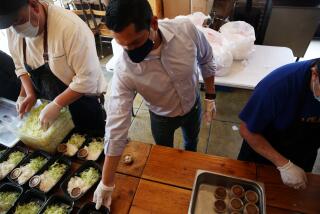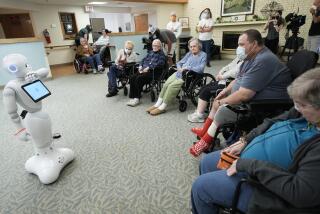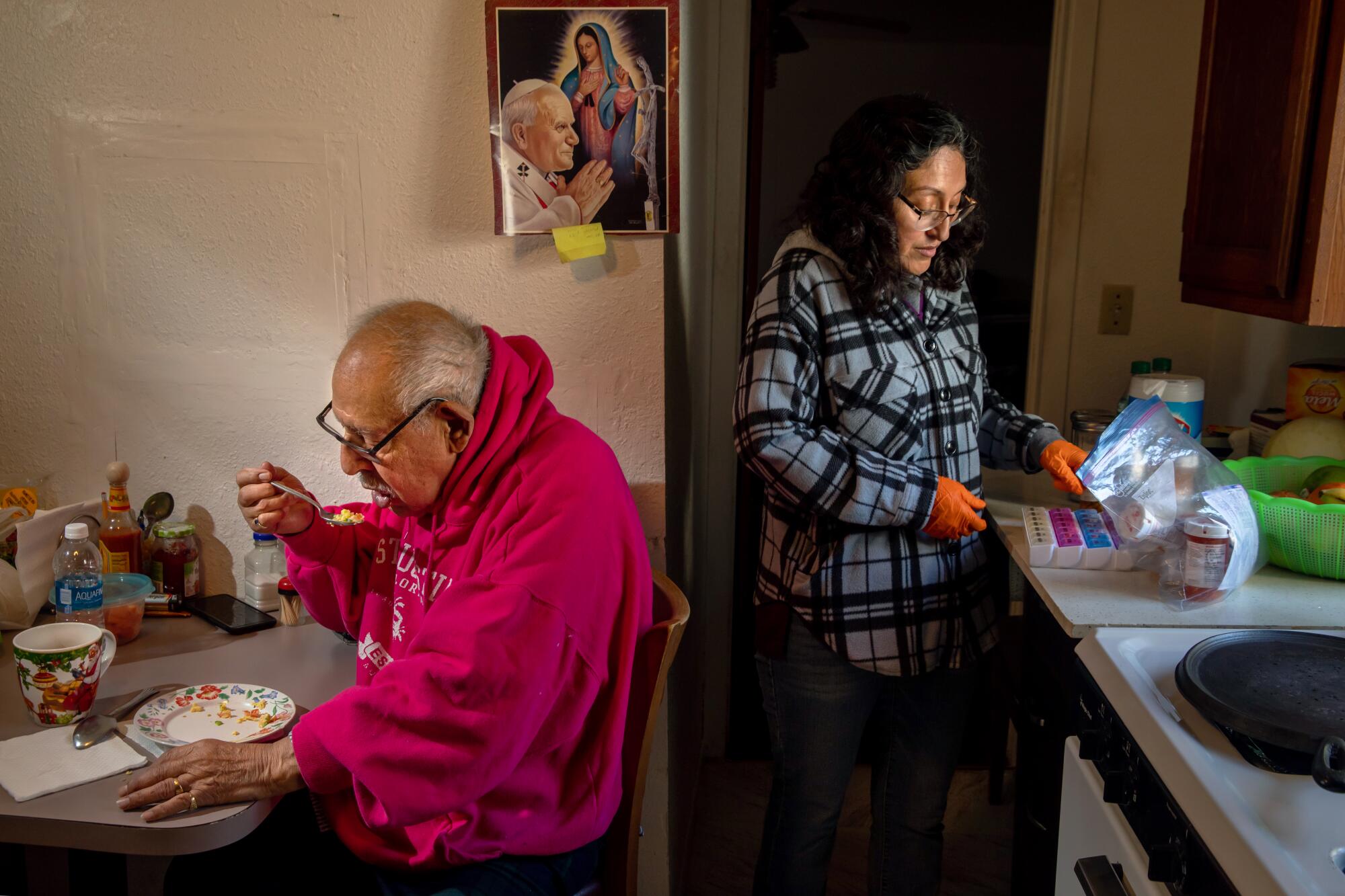
Caregiver Maria Diaz leaves her South Los Angeles home well before the sun rises and returns long after it sets. Days off, even on weekends, are rare. At 46, having recovered from a series of strokes, she is her family’s primary breadwinner and she needs the hours.
“It’s the only way I can make ends meet,” said Diaz, whose husband is disabled.
She has three elderly clients and four young disabled clients, and spends an hour here, three or four hours there, shuttling between Los Angeles, Huntington Park and Gardena. Depending on the need, she cooks and cleans for people, bathes them, changes their diapers, monitors their health and drives them to grocery stores and medical appointments.
Diaz is a slight woman of uncommon strength, which became apparent as she helped lift 86-year-old Luis Aguayo off his bed and shouldered him to the kitchen of his tiny home in the backyard of a house in South L.A. She prepared him a breakfast of eggs and oatmeal, then went off to clean his bathroom while he ate.
Aguayo grimaced in pain, rolled up his pant leg and showed me a scar from knee surgery.
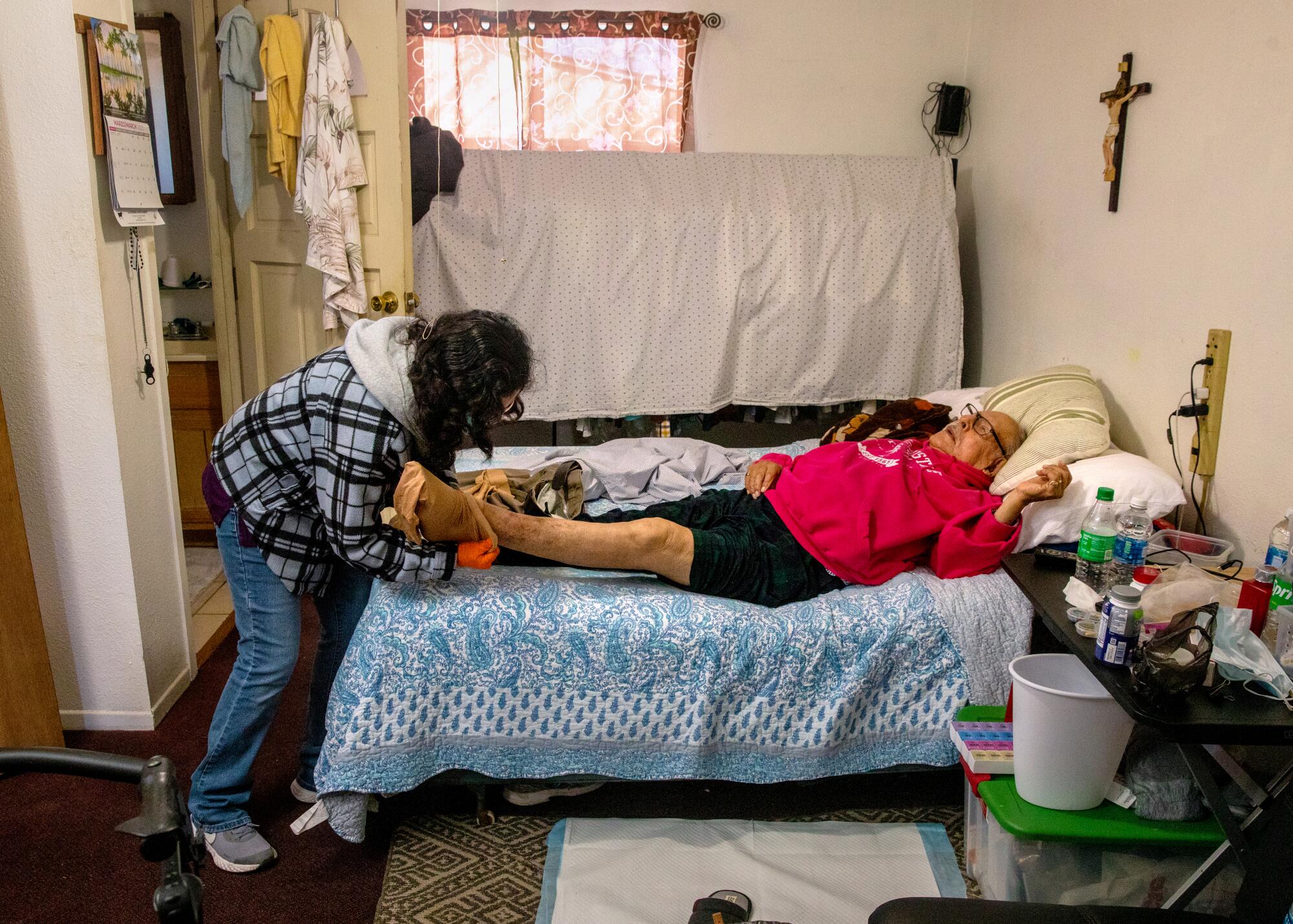
“I want to die,” he said in Spanish, complaining of a dire predicament lightened by daily visits from Diaz. Sometimes, he said with a smile, she’ll come back three or four times a day to make sure he’s OK.
“I worry about him,” said Diaz, who told me she doesn’t mind all the miles she puts on her Nissan Sentra. She said driving provides her only “me time,” and she recharges by listening to sermons, Gospel readings and soothing music on the radio.
On a typical day, she’s out of the house at 4:30 a.m. and back home around 10 p.m.
“I get a couple of hours of rest before my day starts all over again,” said Diaz.
California is about to be hit by an aging population wave, and Steve Lopez is riding it. His column focuses on the blessings and burdens of advancing age — and how some folks are challenging the stigma associated with older adults.
Her weekly hours, which approach the equivalent of two or three full-time jobs, are certainly not the norm in her profession, but she is one of tens of thousands in Southern California who multi-task for a rapidly aging population. Some of them, like Diaz, make a little more than minimum wage, and they’re the lucky ones. Many others toil in an underground economy that often employs undocumented workers.
A few days ago, I met a caregiver named Ricky who said he’s never been paid as much as minimum wage, and a woman named Josephine who showed me the San Fernando Valley studio apartment she shares with two other workers — all of them older than 70. Bare two-by-fours and makeshift partitions were used to carve the apartment into three sleeping quarters. (More on this in an upcoming column.)
When policymakers and academics say society is unprepared for all the aging-related challenges speeding toward us, elder care is a chief concern. At its simplest, the problem is two-pronged:
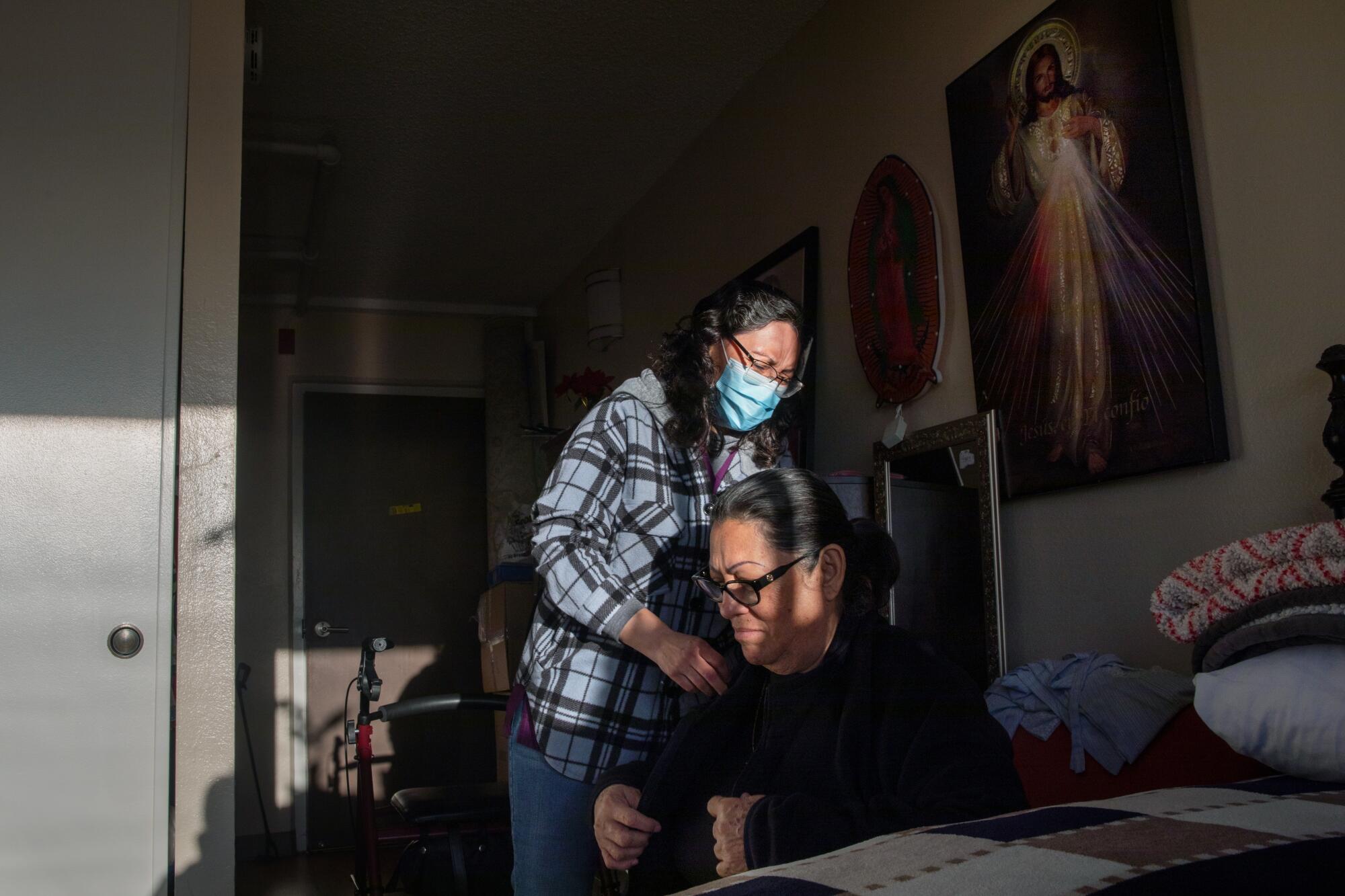
Many aging people are going broke paying for in-home care or nursing facilities, and the care providers can barely survive on the low wages.
“You want to pay people a living wage,” but clearly people are being exploited, said Dr. Laura Mosqueda, a professor of family medicine and geriatrics at Keck USC. “At the same time, you’re talking about many older adults who can’t afford to pay the living wage.”
One possible answer, said Fernando Torres-Gil, a UCLA professor and former U.S. Office on Aging executive, would be “a public universal long-term-care financing mechanism we’re all required to pay into. ... The question is, do we have sufficient public support for it? Do we have a public that recognizes the risks of growing older and all the things that come with it?”
As for the workforce, “the vast majority are women of color” and many of them are approaching senior status themselves, said Arnulfo De La Cruz, president of Local 2015 of the Service Employees International Union. There’s a worker shortage, he added, and “because of the low wages and poor benefits,” it’s hard to attract new caregivers.
Californians who are elderly, blind or disabled — and poor enough to qualify for Medi-Cal — can enroll in the state-run In-Home Supportive Services program, or IHSS. They’re given a set number of weekly hours of care based on their need, and are matched with qualified providers — often their own relatives. The program is seen as a way to help clients stay in their home and avoid the higher costs of hospitals and other institutions.

Patricia Santana, 53, cares for her 78-year-old husband, Ismael Anguiano. She and other workers throughout California have marched and rallied for bumps in pay from levels that vary statewide but have hovered barely above minimum wage. In L.A. County, the hourly wage just increased to $17.25, significantly short of the SEIU goal of $20.
Santana told me that when workers get paid to take care of relatives, some people might think of that as “free money.” But as she sees it, “this is a real job,” and she takes great pride in doing it.
Santana and her husband used to own a grocery store not far from MacArthur Park, along with an auto repair shop and auto salvage company in the San Fernando Valley. They lost all of that, and their home in the Valley, as Anguiano lost his right leg and part of his left foot to diabetes, and he is now blind.
The couple make their home in a cramped studio apartment north of MacArthur Park, on the third level of a building with no elevator. Anguiano sleeps on the lone bed; Santana throws a mattress on the floor at night and sleeps next to him.

IHSS workers aren’t required to have medical training, but many of them have learned some basics out of necessity. Santana, who worked as a nurse in Mexico years ago, swabbed her husband’s left arm and gave him an injection of insulin.
He can’t get out of bed without her help, a feat they’ve choreographed. With a count of one, two and three, she lifts, he leans and pivots — it’s the elder dance of leveraged weight and sheer will. Getting him to the doctor’s office or anywhere else means that Santana has to strap him onto an electric wheelchair that’s like a mini-tractor, with tracks that can manage the stairs.
“It’s 30 stairs,” Santana said after making it down to street level with her husband strapped in and tilted back, nattily attired in a gray suit with a matching fedora because he’s lost his ability to walk but not his pride.
These are difficult but happy times, Santana said, because they have each other.
“We are fighting for the same thing … and you know I love you,” she said to her husband, holding his hand. “Right now, I am your eyes and your legs and your arms and your heart.”
Diaz has had her own experience working with relatives. As an only child whose mother died when Diaz was young, she looked after her father and left her job as a cafeteria worker to take care of him when he became ill. Then her ailing uncle moved in with them and she nursed both men until their deaths.
One of her clients now is her cousin, Maria Martinez, 66, a retired glassware salesperson who has epilepsy and diabetes. It was still dark when Diaz arrived at Martinez’s studio apartment in Huntington Park on a recent morning and spent an hour sweeping, cleaning the bathroom and preparing breakfast.
Diaz set a plate of scrambled egg whites on the table, but she wanted to check her cousin’s blood-sugar level before letting her dig in.
“What did you eat?” she asked after she read the results. Martinez, with a guilty smile, confessed to sneaking some vanilla ice cream a day earlier.
Diaz told her cousin she needed to drink water, take her medication and bring her sugar level down before eating. She covered the eggs with a paper towel and put them in the refrigerator for later.
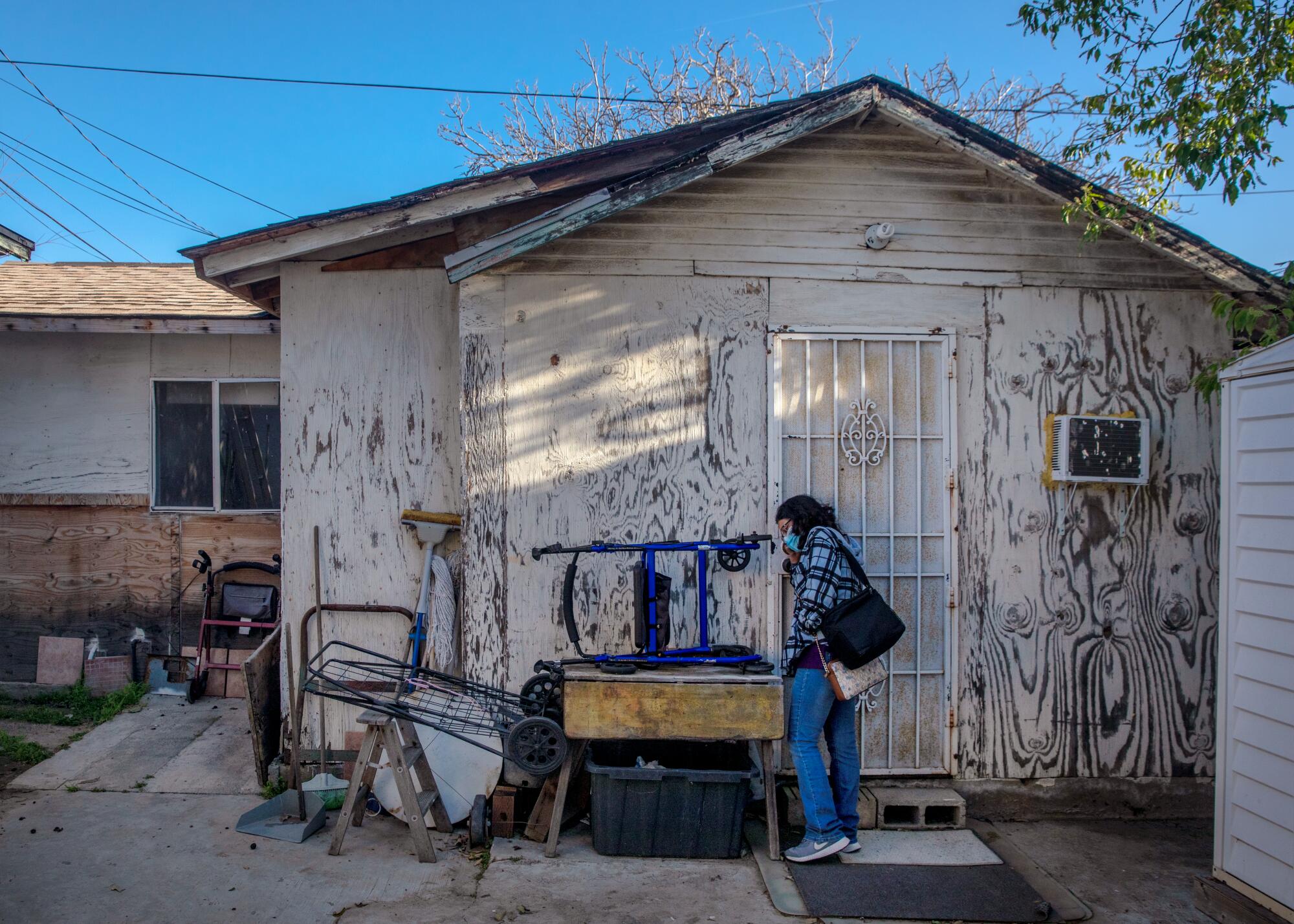
Her next client was Aguayo, the 86-year-old man who shared with me the depths of his despair, and then it was on to the next client, and the next, and the next. Diaz said that back when she cared for her father and uncle, she had four strokes that caused some paralysis on her left side. Doctors told her there was too little sleep and too much stress in her life.
She pays the mortgage on the home she shares with her husband, who has a back condition from years of working in a meat freezer; a son who’s in training to be a physical trainer; and a daughter who has three children. Another daughter is in college, lives on her own and wants to be a doctor.
It would be nice, Diaz said, if wages were high enough that she could work for fewer clients and scale back on the hours. But in anticipation of our meeting, she jotted down some thoughts about the pleasures of her work.
“Knowing that I am helping someone to stay in their own home, and still feel somewhat independent, and have the dignity to live their last days in their own surroundings, gives me joy,” she wrote. “I care for these people like they were my own father or mother. They just need love, compassion and understanding.”
California’s projected shortage of caregivers by 2030, in all job classifications, tops 3 million.
If only Diaz could be cloned.
steve.lopez@latimes.com
More to Read
Start your day right
Sign up for Essential California for news, features and recommendations from the L.A. Times and beyond in your inbox six days a week.
You may occasionally receive promotional content from the Los Angeles Times.


